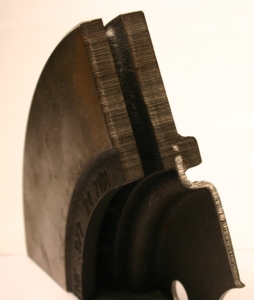 In the 1990s, many cars were trying to increase fuel mileage by reducing the size and weight of the rotors. Many older techs can remember the pulsation problems with the Jeep Cherokee, Chrysler LHS and GM N platform that used undersized or composite rotors. During the next decade, rotor sizes increased and composite rotors went the way of carburators and drum brakes.
In the 1990s, many cars were trying to increase fuel mileage by reducing the size and weight of the rotors. Many older techs can remember the pulsation problems with the Jeep Cherokee, Chrysler LHS and GM N platform that used undersized or composite rotors. During the next decade, rotor sizes increased and composite rotors went the way of carburators and drum brakes.
Now, with more powerful cars some manufacturers are upgrading rotor sizes. They are doing this not only to improve performance but to head off noise and pulsation complaints. Why? because a brake complaint can sink a vehicle’s JD Power ranking.
 Bigger is Better for Brakes
Bigger is Better for Brakes
In this era of rising fuel costs manufacturers are using all kinds of techniques to improve fuel economy.
Smaller engines, aluminum alloy body parts, high strength but thinner steels and more plastic parts are but a few of the features found on today’s vehicles to reduce body weight, and the less a vehicle weighs, the better potential fuel economy it can achieve.
The Bean Counters (accountants in polite circles) also like smaller and lighter. Less material used to build the vehicle means lower costs for raw materials and more profit!
There are some parts of an automobile where bigger is better and nowhere does this show up more than in the braking system. Stopping a car takes a lot of power.
A 200-horsepower engine may accelerate a car from zero to 100 km/h in about eight seconds, yet the brake system can stop that same car from 100 km/h in less than half that time.